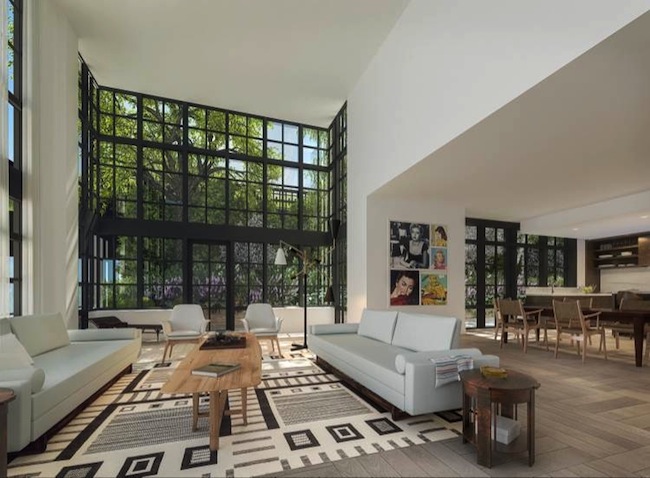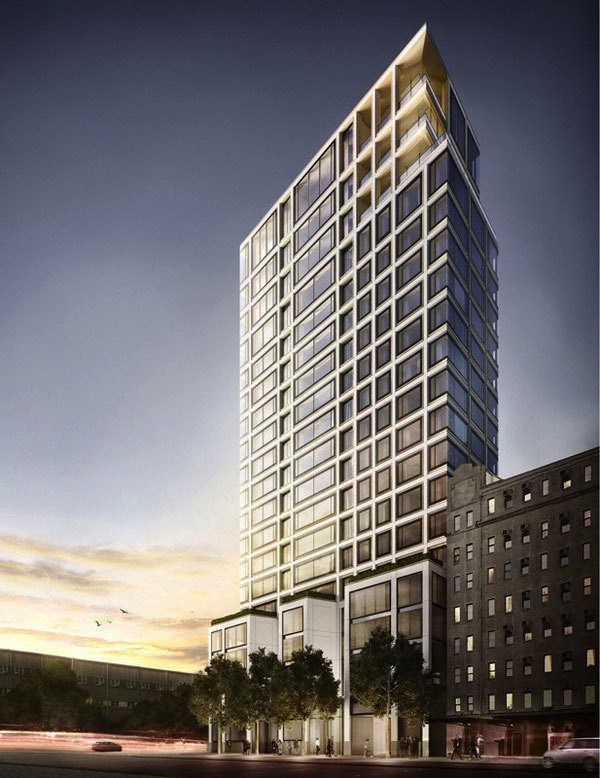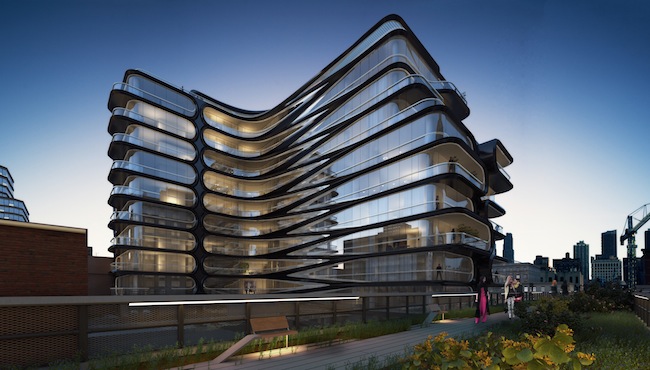The High Line, New York City's elevated park created from a conversion of rail lines, has provided an organizing principle for a series of luxury condo buildings designed by big names in architecture, including Zaha Hadid, Norman Foster, and Robert A.M. Stern.
Vox Media's e-journal Curbed NY has compiled a nifty presentation mapping the developments, with mini-profiles of these upcoming and recently completed buildings.
From new builds to the conversion of a former women's prison, these facilities will change the face of the Big Apple. (Comments at Curbed, regarding the prospect of numerous luxe towers overlooking the park, range from "great social good" to "we killed the thing we loved.")
Enjoy Curbed's presentation at this link. Here's a look at some of the projects:

Abington House (center); rendering courtesy Related Properties and Robert A.M. Stern.

500 West 21st. Rendering courtesy Sherwood Equities and Kohn Pedersen Fox.

551W21, by SR Capital and GTIS Partners. Rendering courtesy Foster + Partners.
Want a first-hand view of the hip High Line scene? BD+C's fourth annual Under 40 Leadership Summit, Sept. 17-19, will be headquartered at the High Line Hotel (a former theological seminary and federal Historic Landmark). Our many tour options include a walking tour of the Far West Village, including the High Line. Check out the agenda for this exciting leadership development event!
Related Stories
| Jan 19, 2011
Architecture Billings Index jumped more than 2 points in December
On the heels of its highest mark since 2007, the Architecture Billings Index jumped more than two points in December. The American Institute of Architects reported the December ABI score was 54.2, up from a reading of 52.0 the previous month.
| Jan 19, 2011
Large-Scale Concrete Reconstruction Solid Thinking
Driven by both current economic conditions and sustainable building trends, Building Teams are looking more and more to retrofits and reconstruction as the most viable alternative to new construction. In that context, large-scale concrete restoration projects are playing an important role within this growing specialty.
| Jan 10, 2011
Architect Jean Nouvel designs an island near Paris
Abandoned by carmaker Renault almost 20 years ago, Seguin Island in Boulogne-Billancourt, France, is being renewed by architect Jean Nouvel. Plans for the 300,000-square-meter project includes a mix of culture, commerce, urban parks, and gardens, which officials hope will attract both Parisians and tourists.
| Jan 10, 2011
Michael J. Alter, president of The Alter Group: ‘There’s a significant pent-up demand for projects’
Michael J. Alter, president of The Alter Group, a national corporate real estate development firm headquartered in Skokie, Ill., on the growth of urban centers, project financing, and what clients are saying about sustainability.
| Jan 7, 2011
BIM on Target
By using BIM for the design of its new San Clemente, Calif., store, big-box retailer Target has been able to model the entire structural steel package, including joists, in 3D, chopping the timeline for shop drawings from as much as 10 weeks down to an ‘unheard of’ three-and-a-half weeks.
| Jan 7, 2011
How Building Teams Choose Roofing Systems
A roofing survey emailed to a representative sample of BD+C’s subscriber list revealed such key findings as: Respondents named metal (56%) and EPDM (50%) as the roofing systems they (or their firms) employed most in projects. Also, new construction and retrofits were fairly evenly split among respondents’ roofing-related projects over the last couple of years.
| Jan 7, 2011
Total construction to rise 5.1% in 2011
Total U.S. construction spending will increase 5.1% in 2011. The gain from the end of 2010 to the end of 2011 will be 10%. The biggest annual gain in 2011 will be 10% for new residential construction, far above the 2-3% gains in all other construction sectors.
| Jan 7, 2011
Mixed-Use on Steroids
Mixed-use development has been one of the few bright spots in real estate in the last few years. Successful mixed-use projects are almost always located in dense urban or suburban areas, usually close to public transportation. It’s a sign of the times that the residential component tends to be rental rather than for-sale.














